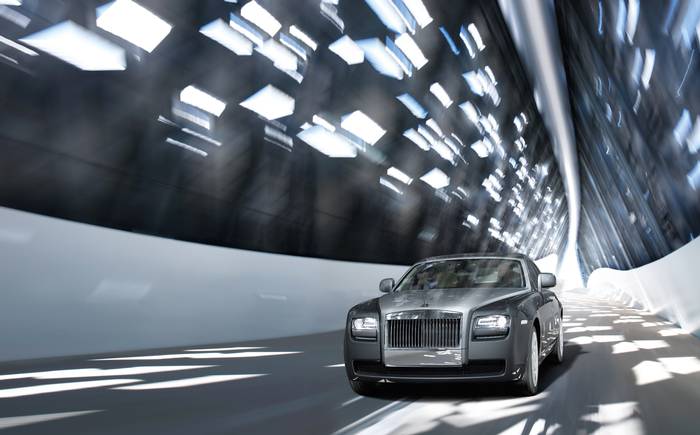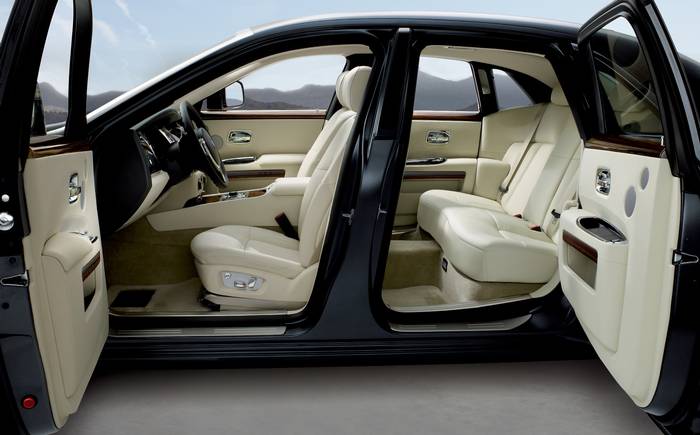Rolls-Royce Ghost review (2009-on)
Nobody does opulence better than Rolls-Royce, and the Ghost is the most 'affordable' way to access it

What is the Rolls-Royce Ghost?
Smaller but quicker and more powerful than a Phantom, the Ghost was conceived as the drive-it-yourself “entry-level” Rolls-Royce saloon. Sitting between the Bentley Flying Spur and Mulsanne in price and available with an extended-wheelbase option (a two-door coupé went into production in 2013), it is no less imposing than the Phantom and is every bit as well soundproofed and well insulated from the ranks of the great unwashed.
Under the surface, the Ghost shares much with the BMW 7-series — including its twin-turbo 6.6-litre V12, here tuned to produce 563bhp. However, attention has been paid to all the necessary details to ensure that it’s not just a rebodied 760 Li, and the Ghost does feel every inch an authentic Rolls-Royce, complete with its rear-hinged rear doors. It has a slightly sportier ambience than the Phantom — a head-up display, a thicker steering wheel, a lower driving position — but otherwise has clearly been furnished by the same Goodwood team.
A revised model (the Ghost II) introduced for model-year 2014 has re-designed LED-type headlights, re-sculptured bumpers and a modified bonnet, and brought with it new paint-colour and wheel options. Inside the Ghost II can be found re-designed front seats, an upgraded clock fascia and instrument dials and the addition of two new crafted veneers: Paldao and Walnut Burr Crossband. A Ghost II is easily identified from outside by a slightly different headlight shape featuring a step in its lower edge.
Suspension improvements were also made for 2014, and include re-engineered front and rear struts, new steering gear and dampers adjusted to increase the big saloon’s cornering prowess when it’s fitted with the optional Dynamic Driving Package. New rear-axle bearings enhance the ride and rear stability, while reducing vibration and cabin intrusion. All Ghost Series II cars have Satellite Aided Transmission as standard — a technology that employs GPS and mapping data to ensure the car is always in the correct gear when negotiating turns, motorway exists and roundabouts.
The drive

The ride is softly sprung, though: comfort is not sacrificed for agility. The finely tuned, adjustable air suspension contains body roll and allows you to proceed at a fair pace — because, of course, the Ghost is also exceedingly fast. Some critics suggest that the low-speed ride can be unsettled over poor road surfaces, but the potholes and ruts do have to be large, and tackled with very little sympathy, to disturb seriously the Ghost’s composure.
It is, of course, a large and bulky vehicle to manoeuvre around town, but rear-view and perimeter cameras and huge door mirrors go some way to compensate for the small rear window.
The eight-speed automatic has no paddles or Sport mode, but does not need them: the transmission works seamlessly with the V12 engine, which manages to accelerate this near-2.5-ton car to 62mph in 4.9 seconds (five seconds in the EWB models, which have an extra 170mm and 60kg to lug along). The steering is a little light, but direct and involving all the same — it’s not one of the wafty, floating Rollers. However, keen drivers will probably still prefer an Aston Martin Rapide.
If you’re in the market for a Rolls-Royce, running costs are probably by the by, but its fuel consumption is not the worst (20.8mpg; 20.6 from the extended-wheelbase version) and depreciation from the flabbergasting £201,450-plus new price is, surprisingly, less harsh than for some rivals.
The interior

It won’t be a cheap second-hand buy for a while yet, but if you’re after the best possible value for money, then look for cars that have desirable options already fitted, such as the power-reclining rear seats, full-length sunroof and lambswool carpets.
Don’t worry that the Ghost, the smallest Rolls-Royce, is inferior to the marque’s Phantom model, because it really isn’t. Its cabin is very different from the Phantom’s, and is in fact cosier, lower and more modern in feel, yet every bit as prestige. Features such as the piano-black wood trim, abundance of chromed fittings, and the dyed leather are of irreproachable quality and luxury.
The driver sits in an elevated position, as befits such a haughty conveyance, with smart black-on-white instrument dials immediately before him and the major switchgear sensibly arranged within easy reach. While most of these controls are “borrowed” from the BMW 7-series on which much of this car is based, Rolls-Royce has quite clearly been careful to ensure that none of it is immediately recognisable from the Beemer, which in this majestic company is very much the poor relation.
If you travel in a Rolls-Royce you expect to be cosseted by it, and it will certainly relax you with its vast stretching-out space, marvellously comfortable seating, voluptuous smoothness of ride and uncanny virtual silence.
While the Ghost ‘s rear seats are not adjustable (at least not as standard – adjustable seats are a very costly option) that shouldn’t be a problem for many passengers, but if you long for rear seating that can be further reclined, that should be one of the extras you look for among used Ghosts when you’re out hunting for a used one.
What to look out for
A Rolls-Royce does not break down, but instead “fails to proceed”. And should your Ghost indeed fail to proceed, the Rolls customer service team should be on hand to help you out, even if you’re a second-hand buyer: the company does not want its cars to be seen stranded on the roadside or on the back of a truck. Buying through the Rolls-Royce approved-used scheme will offer the best protection, with a two-year warranty and free servicing within that period.
All the Ghost’s grubby bits are BMW-developed, as are its electrics and electronics, and the car itself is assembled and painstakingly hand-finished on the assembly lines at Goodwood. There have been factory recalls, however, and along with various BMW models that share its components, Ghosts built between September 2009 and September 2010 were recalled for the replacement of a faulty circuit board related to the electric water pump that cools the turbochargers, which could overheat and cause an engine fire. A further recall was issued to address the risk of the water pump itself possibly cracking, which could lead to a melting of the plug connections and their housing, overheating and an engine fire.
Make sure all remedial work has been carried out, and it goes without saying that you’ll want your Ghost to have been serviced to schedule. It’s a complex machine, which will cost a lot to fix if it does go wrong.
The one to buy
Rolls-Royce Ghost (Series I)
Factfile
- Engine:
- 6592cc, V12
- Power:
- 563bhp @ 5250rpm
- Torque:
- 575 lb ft @ 1500rpm
- Transmission:
- 8-speed automatic
- Acceleration:
- 0-62mph in 4.9sec
- Top Speed:
- 155mph
- Fuel
- 20.8mpg (combined)
- CO2:
- 317g/km
- Road Tax Band:
- M
- Dimensions:
- L 5399mm, W 1948mm, H 1550mm




